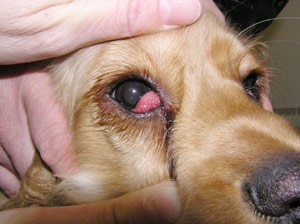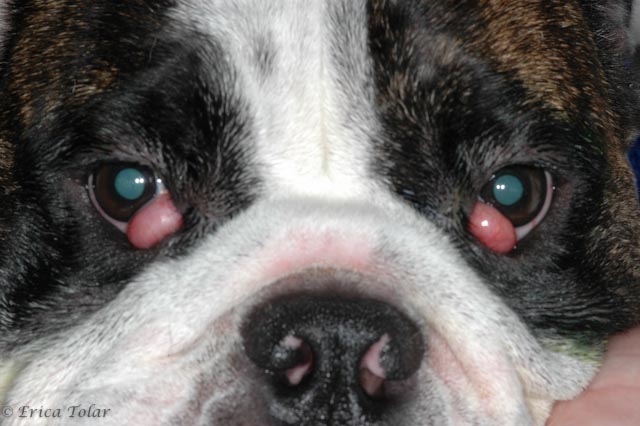Cherry eye can affect any dog, but some breeds are more susceptible to the condition than others. This condition can manifest itself in either one or both eyes of a dog, and it is beneficial for a dog owner to be aware of the breeds that may be predisposed to it as well as how to recognize it.
Table of Contents
What is Cherry Eye?
Is cherry eye in dogs an emergency?
Even though it is not an emergency, a cherry eye can cause serious problems for the dog if left untreated. The majority of dogs who develop a “cherry eye” are younger than two years of age. It is likely that it will prolapse again if it does so once.
“Cherry eye” is a nickname for a medical condition known as prolapsed nictitating membrane, prolapsed third eyelid, or third eyelid gland prolapse, all of which are related to the eyelids. The nictitating membrane, also known as the third eyelid, is a fleshy, pink part of the eye socket that sits next to the eye. This membrane is actually a flap of tissue that contains a gland that secretes tears, and it is usually difficult to see because it is hidden within the tissue. It should be flat and against the corner of the eye socket, but in a dog with cherry eye, it enlarges, flips over, and protrudes or prolapses, making it abnormally visible in the field of vision.
Signs of Cherry Eye in Dogs
- Bulge of pinkish color in one corner of the eye
- Putting your paw or rubbing your eye
- I was unable to close my eyes.
A cherry eye is characterized by a pink or red bulge that appears to be coming out of the inner corner of the eye in a dog’s eye. This bulge will not be bleeding and will not be painful, but it is usually quite noticeable to the owner. Sometimes the bulge will come and go, but other times the cherry eye will remain out indefinitely until veterinary care has been obtained for the dog. Aside from the obvious pink bulge in the eye, your veterinarian may notice other problems and symptoms in a dog with cherry eye, such as dry eye, corneal ulcers, irritation, and inflammation of the cornea, among other things. As a result of these circumstances, the dog may paw at or rub its eyes.
Due to a decrease in tear production, dry eye develops. Because the third eyelid is responsible for producing tears, if it is inflamed and not producing enough tears, the eye will not be adequately lubricated. This can then result in irritation, inflammation, and even ulcers on the cornea, especially if the eye is pawed at or rubbed against the ground by a dog. Dogs may find it difficult or impossible to completely close their eyes if a cherry eye is large enough on their face. If the eye is kept partially open all of the time, this can also be a contributing factor to dry eye.
Causes of Cherry Eye in Dogs
Cherry eye can be present at birth in some dogs, but it is more common in those who have had it for a long period of time. Generally, dogs under the age of two years are more susceptible to developing cherry eye than older dogs, but some breeds are more susceptible to developing the condition than others. Breeds such as American Cocker Spaniels, Shih Tzus, Beagles, Lhasa Apsos, Pekingese, Maltese, Bassett Hounds, Rottweilers, Neapolitan Mastiffs, Shar-Peis, Boston Terriers, St. Bernards, and English Bulldogs are examples of these types of animals.
Treatment of Cherry Eye in Dogs
Can cherry eye go away on its own?
Although the swelling may come and go, if left untreated, it can lead to serious complications. The condition known as Cherry Eye cannot be prevented; however, it is treatable through surgery, and the prognosis is best when it is discovered early.
Cherry eye in dogs has been successfully treated with a variety of surgical techniques over the years. The surgical replacement of the cherry eye is the preferred treatment option because it preserves the tear production in the gland; however, the gland must occasionally be removed in order to maintain the tear production. If the surgical replacement is unsuccessful and the removal of the gland is required, there is a risk that your dog will develop chronic dry eye, and your dog will be closely monitored for this condition after the procedure. If the gland has just popped out, pressing or massaging the cherry eye back into place with a wet cloth at home may be sufficient, but this will depend on the severity of the cherry eye and the length of time it has been out of position. The majority of the time, this is only a temporary fix, if it even works at all.

Although serious complications from Cherry Eye surgery are rare, it is possible for the cherry eye to recur after the procedure. After a Cherry Eye repair, an owner should expect some postoperative swelling, but this should subside and the eye should be comfortable and normal in appearance after about a week.
Your veterinarian will select the surgical plan for replacing the cherry eye that they are most comfortable with, but one of three methods is typically used in combination with a modification of the other two. The three most commonly used methods are known as orbital rim anchoring, scleral anchoring, and the pocket method, which is the most popular of them all. Variations of the pocket method have been shown in some studies to be the most successful3 surgical plan for cherry eye replacements, and as a result, many veterinarians choose to use that technique.
An E-collar should be worn until the eye has completely healed. Various medications, both oral and ocular, may be prescribed to help manage pain and inflammation as well as prevent infection. Damage to the surgical site will be minimized as a result of this. In addition, when your dog’s eye is rechecked after surgery, the tear production may be monitored to ensure that the replaced gland is still adequately producing enough tears and that your dog does not have dry eye. If dry eye has developed, it will be necessary to use eye medications for the rest of one’s life.
How to Prevent Cherry Eye in Dogs
No one is certain what causes this condition, but some dogs appear to be predisposed to it due to a genetic predisposition to developing it. Fortunately, it is not a life-threatening condition and can be managed with surgery and medication.


What Is the Surgery Like?
The procedure is considered to be fairly straightforward, with a short recovery period and only a few long-lasting aftereffects.
It is possible to reattach the gland using a variety of techniques, and opinions on which are the most effective and long-lasting are sometimes divided.
How is cherry eye diagnosed?
Whenever you have a suspicion that your dog may be suffering from cherry eye, you should take him to the veterinarian’s office as soon as you can.
A visual examination is usually sufficient to confirm a diagnosis, but a veterinarian may order additional testing if they suspect a more serious condition – such as cancer – may be present – in this case, chemotherapy.
In most cases, a comprehensive eye examination is recommended, which includes the following tests: a Schirmer tear test (which assesses tear production), a Fluorescein dye test (which checks for corneal ulcers), and a Tonometry test (which measures the amount of fluid in the eyes) (checks the pressure in the inside of the eye).
Are there any Natural Treatment for Cherry Eye?
Cherry eyes may be able to be treated with a natural remedy in some cases.
According to the theory, if the third eyelid can pop out, then it can also pop back in again.
In most cases, a trip to the veterinarian will result in a few anti-inflammatory pills or an injection, followed by a simple massaging session.
The majority of the time, cherry eyes can be massaged back into their proper position without the need for surgery.
If your dog has had the cherry eye condition in the same eye on more than two occasions, your veterinarian may be unwilling to perform the massage procedure and may recommend surgery instead because the dog appears to be susceptible to a repeat cherry eye condition in the same eye.
What Are the Long-Term Effects of Cherry Eye?
When the tear duct is exposed for an extended period of time, it can cause problems for the patient. For example, if blood flow is restricted to the gland, swelling may result, which may impair your pet’s vision and cause it to become blind. It is possible that your pet will want to paw or rub their eyes, increasing the likelihood of an infection in the eye.
It can also cause redness to spread throughout the eyes. Recovery is very likely for your pet as long as he or she receives professional medical care. However, just because you have successfully treated cherry eye in one eye does not mean that it will not occur in the other.
Your veterinarian will be able to provide you with any additional treatment recommendations for your pet.
Do you have any questions or concerns about the health of the eyes in your pet? Please get in touch with us!
What does recovery look like?
Specific instructions may vary depending on your pet’s individual requirements, but the following is a general outline of what your pet will likely receive after their surgery:
Your veterinarian will also instruct you on how to monitor your pet at home and when it is necessary to return for another examination.
What is Dry Eye in Dogs?
Dry eye is an ocular condition that occurs when the tear glands do not produce enough tears to adequately lubricate and protect the eye from injury.
Consequently, the eye becomes dry and inflamed, which increases the risk of infection.
Keratoconjunctivitis sicca, also known as dry eye, is a condition that affects the conjunctiva.
The word “kerato” refers to the cornea, which is a clear covering that covers the front of the eye.
Conjunctivitis is an inflammation of the thin membrane that coats the eye and eyelids, which is caused by bacteria or viruses.
The word “sicca” literally translates as “dry.”
An unobstructed view of the eye reveals the presence of lacrimal glands (tear glands), which are located above the eye and within the third eyelid, which can be found in the lower inner corner of the eye.
Normal functioning lacrimal glands produce tears that contain a mixture of water, salts, oil, and mucus, among other substances.
It is through tears that the eyes are kept lubricated and that debris is flushed from the eyes that can cause irritation and infection.
If the eye does not produce enough tears, it can be injured by debris and even become infected as a result of the infection.
The cornea thickens as a result of the body’s attempt to protect the remainder of the eye from injury.
The tear glands may continue to produce oil and mucus, but they will not produce water.
This may result in a thick discharge from the eyes and around the eyes.